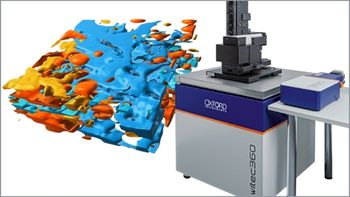
Metal Ion Leaching from Stainless Steel and Hastelloy in Common Pharmaceutical Solvents and its Impact on Production and Analysis: An Interview with Jesse Bischof
Spectroscopy sat down with Jesse Bischof of SilcoTek to discuss metal ion leaching data measured using inductively coupled plasma-mass spectrometry (ICP-MS).
Leaching occurs when metals ions make their way into the pharmaceutical production process and interact with the active ingredients within the medication. As small as parts-per-billion (ppb) variation of elements such as iron, chromium, nickel, and manganese can negatively impact the pharmaceutical production process. Suppliers of raw materials diligently attempt to control the amount of metal in their product so as not to negatively impact their formulations. However, once these materials are stored, distributed, and processed in stainless steel or hastelloy (a nickel alloy used for its high resistance to corrosion) components, leaching can still occur and cause problems. At the recent Pittcon Conference, Jesse Bischof of SilcoTek presented metal ion leaching data measured using inductively coupled plasma-mass spectrometry (ICP-MS) and described a method to mitigate leaching in the form of a nano chemical vapor deposition (CVD) silicon-based coating. This coating is added to block metal ions from leaching into various pharmaceutically relevant solvents such as water, methanol, and acetonitrile, both in their pure forms as well as in mixtures. The results showed that, after the application of this coating to tubing, valves, filters, tanks, and any other metal processing equipment, metal ions in product can be limited to sub-ppb levels of leaching, thus providing greater control over various pharmaceutical processes. Bischof discussed the CVD silicon coating approach with us shortly after his technical presentation.
Briefly discuss the impact of metal ion leaching on pharmaceutical production.
In pharmaceutical production, specifically biopharmaceutical production, metal concentrations need to be tightly controlled to optimize yields, prevent product degradation, reduce irreversible protein aggregation, among many other issues. This problem is not limited to just pharmaceutical production, either. Any process requiring microbes for their process would benefit from tight control over metal ion concentrations, including beer and wine fermentation, cheese and yogurt production, and chemicals that are manufactured via microbial fermentation such as citric acid from Aspergillus niger. Much of this is well known and documented in the literature, so many scientists take care to get metal concentrations in their cell culture media into the proper range, but metal ions leaching into the media can occur and dramatically impact those concentrations. Unfortunately, the leaching can be unpredictable and can lead to batch-to-batch product variation.
How do metal ions get introduced into the drug manufacturing process?
Stainless steel has been the alloy of choice for most pharmaceutical production facilities for over a century. It is used due to its resistance to harsh chemicals, and it can hold up to sterilizations processes. It is used for tubing, valves, pumps, tanks, filtration, and more. The material often appears to be unaffected by exposure to various solvents as there are no obvious signs of rust or corrosion, but the leaching of metals at ppm levels and even lower levels are constantly occurring. This leaching often has no visual impact to steel surfaces, so it goes unnoticed. For highly corrosive situations, some turn to Hastelloy as an alternative to stainless steel, but even that alloy is susceptible to ppb and ppm levels of leaching metal ions.
Please summarize the scenario covered at your recent talk that inspired your research.
There are many areas where metals are exposed to fluidic flow paths, but one of the first areas we targeted was in separation and purification processes, specifically column hardware for high performance liquid chromatography (HPLC) and prep separations. In an HPLC system, the column alone accounts for at least 75% of the metallic surface area. Many pharmaceutical molecules are prone to non-specific bonding to metal surfaces as well as metal ions that leach into the separation media causing sticking sites as well. We had an end user that was operating under high pH, high salt content, and relatively high temperatures for an oligonucleotide purification. They were trying to collect impurities for liquid chromatography-mass spectrometry (LC–MS) analysis on a semi-prep system. After about 6-8 injections on the column, the impurities that they were trying to collect were lost in the noise of the chromatogram and no longer able to be separated. They opened their column to find the frit and end cap covered in rust spots and the top of the separation media to be brownish orange, rather than white. While we worked to address their problem, it got us wondering: What conditions cause this metal ion leaching? There are some obvious answers such as acidic conditions or higher temperatures that can cause larger quantities of metal ions to solvate, but what about benign conditions? What would just water or acetonitrile or methanol do to stainless steel surfaces at room temperature?
In your session, you presented metal ion leaching data via ICP-MS. What was the benefit in using this technique as opposed to other atomic methods?
The detection limits of ICP-MS for these metal species were the main reason for choosing it. Some samples were only leaching ppb levels of metals, which is well within the capabilities of ICP-MS. For other samples that are leaching ppm levels of metal ions, ICP-optical emission spectrometry (OES) or atomic absorption spectroscopy would be sufficient, or even favorable, as they have better quantitation in these concentrations.
Please discuss the steps you took to resolve any challenges you encountered and summarize your findings.
One of the largest challenges that we have run into with this testing is the huge variability of metal leaching from stainless steel and hastelloy materials, especially for sintered frits. Even within the same order from the same company, the leaching rates of these materials can vary drastically, let alone considering one company to another company’s product. I would imagine there are many separation scientists out there that wonder how or why the exact same column from a company can have such drastically different responses, especially to metal sensitive analytes.
Could this possibly have to do with the different suppliers of the stainless-steel raw material that component manufacturers use?
We have certainly seen differences from different suppliers of stainless steel, but we have also seen differences from the same company purchasing the same stainless steel raw material from the same vendor. There seems to be lot to lot variation even with the entire supply chain being consistent.
How does the use of chemical vapor deposition (CVD) silicon-based coatings mitigate metal leaching for exposed metallic surfaces?
CVD coatings provide a uniform barrier across three-dimensional surfaces to block interactions between the solvents and the metal surfaces. This means that analytes are not exposed to metal surfaces and metal ions are not leaching into the solvent. One nice part about thermal CVD depositions is that the coating can penetrate small pores, such as those found in sintered metal frits.
What were your findings for the metal leaching test for CVD coated verses non-coated metals?
Depending on the solvent system and temperature, metal surfaces can leach anywhere from single digit ppb levels of metal up to near percent levels. The CVD coated metals showed near baseline (what was already present in the solvent before the test) amounts of metal ion leaching. For instance, pure water at 60 °C causes over 2 ppm of metals to leach from an uncoated stainless-steel sample. With those same conditions, a coated sample showed under 5 ppb when corrected to baseline concentrations.
What best practices that can you recommend for oligo recovery analysis using a coated column and frit system?
We’ve heard from end users that oligonucleotides sticking to metal surfaces can cause a lot of frustration, especially when trace analysis is the goal. The silica-like coating will allow for this analysis to be done without the negative effects from exposed metal surfaces. The coating is also durable and resistant to most chemicals that would be used in such an analysis. We have seen that for non-metal active materials, there is no difference between a coated system and an uncoated system. At the same time, we have received reports of the coating helping with compounds that were otherwise seen as non-metal active, and we have also seen an increase in column lifetimes.
Can you please summarize the feedback that you have received from others regarding this work, especially the individual who had the initial issue and brought it to your attention?
Thus far, the feedback regarding coated column hardware has been positive. The oligonucleotide scientist that was only getting 6-8 injections before their impurities were lost in the baseline noise reported that they were getting 100x lifetime improvements on his column. At that point they stopped the experiment and were so satisfied with the results, they ended up sending us the rest of their flow path as well for coating: capillary tubing, pump heads, valves, and so forth.
Are there any next steps in this research?
The next step is to look at more mobile phase additives and take a deep dive into quantifying the metal leaching impact on stainless steel and hastelloy. We’ve seen some ion pairing additives like triethylammonium acetate that cause an increase in metal ion leaching and others such as triethylamine hexafluoroisopropanol that have a passivating effect and reduce the metal leaching. The plan is to look at some common HPLC additives like formic acid, acetic acid, perchlorate salts, phosphate buffers, ammonium acetate, as well as some common pharmaceutical ingredients like citric acid, guanidine HCl, and histidine. We want to know which of these additives could have the biggest impact to metal ion leaching and explore how our coatings could reduce this leaching to help both upstream and downstream pharmaceutical scientists.
About Jesse Bischof
Jesse Bischof began his career teaching high-school chemistry before returning to graduate school at Penn State where he earned his PhD in chemistry. Upon completion of his degree in 2016, Bischof began his role as a scientist in SilcoTek’s research and development department. Currently, Bischof research is focused on developing and optimizing bio-inert and anti-metal leaching coatings for medical, semiconductor, and analytical markets.
Newsletter
Get essential updates on the latest spectroscopy technologies, regulatory standards, and best practices—subscribe today to Spectroscopy.




